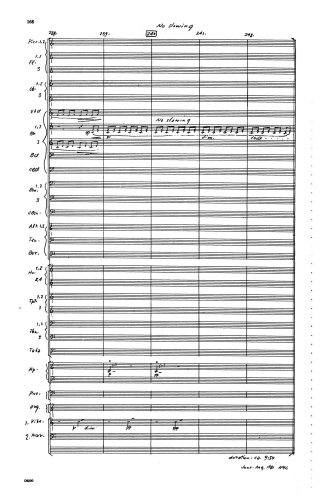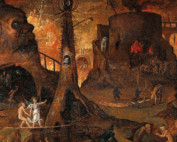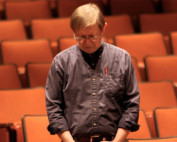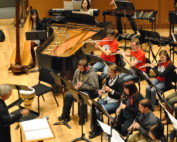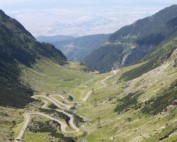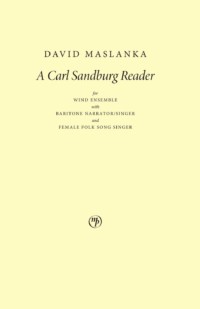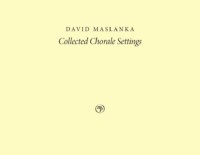Project Description
Wind Ensemble
1981
35 min.
Grade 6+
Listen Now
University of Massachusetts at Amherst Wind Ensemble, Malcolm W. Rowell, Jr., cond.
On the album, Wind Music of David Maslanka (1996)
Instrumentation
- Piccolo (2)
- Flute (3)
- Oboe (3)
- Clarinet in E♭
- Clarinet in B♭ (3)
- Bass Clarinet in B♭
- Contrabass Clarinet in B♭
- Alto Saxophone (2)
- Tenor Saxophone
- Baritone Saxophone
- Bassoon (3)
- Contrabassoon
- Horn in F (4)
- Trumpet in B♭ (3)
- Optional C or E♭ Trumpets in Mvt. 1: mm. 78-106
- Trombone (2)
- Bass Trombone
- Euphonium (opt.)
- Tuba
- Harp
- Piano
- Electric Organ
- Required Percussion (6 players)
- Antique Cymbals (C, C, D)
- Anvil
- Bass Drum
- Bongo (2 sm)
- Bongo (2 med)
- Crash Cymbals
- Crystal glass (2, filled with water to sound B4 and C5, taped to wooden table)
- Gong (4 sm of different sizes and timbres. If necessary, 4 small suspended cymbals may be substituted)
- Hi-hat Cymbal
- Marimba
- Orchestra Bells
- Ratchet
- Sizzle Cymbal
- Slide Whistle (tin penny whistle)
- Snare Drum
- Suspended Cymbal (sm, lg, w/ cello or bass bow)
- Tam-tam
- Tambourine
- Temple Block (3 sm, med, 3 lg)
- Tenor Drum (3)
- Tom-tom (3 sm, 3 med, 4 lg)
- Triangle (lg)
- Vibraphone
- Wood Block (2 sm, lg)
- Xylophone
Movements
- There is a desert on the moon where the dreamer sinks so deeply into the ground that she reaches hell.
- A drunken woman falls into the water and comes out renewed and sober.
- A horde of small animals frightens the dreamer. The animals increase to a tremendous size, and one of them devours the little girl.
- A drop of water is seen as it appears when looked at through a microscope. The girl sees that the drop is full of tree branches. This portrays the origin of the world.
- An ascent into heaven where pagan dances are being celebrated; and a descent into hell where angels are doing good deeds.
Commissioned by
Premiere
Errata
- Movement 4
- 117: Horns have a written E♭; it should be a written F♮
- Movement 5
- 61: Bar. Sax has a new time signature of 5/4; it should be 4/4
Program Note
A Child’s Garden of Dreams was commissioned by John and Marietta Paynter for the Northwestern University Symphonic Wind Ensemble. It was composed in the summer of 1981 and premiered by Northwestern in 1982.
The following material is from Man and His Symbols by Carl Jung:
A very important case came to me from a man who was himself a psychiatrist. One day he brought me a handwritten booklet he had received as a Christmas present from his ten-year-old daughter. It contained a whole series of dreams she had had when she was eight. They made up the weirdest series of dreams I had ever seen, and I could well understand why her father was more than just puzzled by them. Though childlike, they were uncanny, and contained images whose origin was wholly incomprehensible to the father….
In the unabridged German original, each dream begins with the words of the old fairy tale: “Once upon a time….” By these words the little dreamer suggests that she felt each dream were a sort of fairy tale, which she wants to tell her father as a Christmas present. The father tried to explain the dreams in terms of their context. But he could not do so because there appeared to be no personal associations with them….
[The little girl] died of an infectious disease about a year after that Christmas….” [The dreams were a preparation for death, expressed through short stories, like the tales told at primitive initiations.]The little girl was approaching puberty and at the same time, the end of her life. Little or nothing in the symbolism of her dreams points to the beginning of a normal adult life…. When I first read her dreams, I had the uncanny feeling that they suggested impending disaster….
These dreams open up a new and rather terrifying aspect of life and death. One would expect to find such images in an aging person who looks back upon life, rather than to be given them by a child…. Their atmosphere recalls the old Roman saying, “Life is a short dream,” rather than the joy and exuberance of its springtime…. Experience shows that the unknown approach of death casts an adumbratio (an anticipatory shadow) over the life and dreams of the victim. Even the altar in Christian churches represents, on the one hand, a tomb, and on the other, a place of resurrection – the transformation of death into eternal life.”
I have selected five of the twelve dreams as motifs for the movements of this composition:
- There is a desert on the moon where the dreamer sinks so deeply into the ground that she reaches hell.
- A drunken woman falls into the water and comes out renewed and sober.
- A horde of small animals frightens the dreamer. The animals increase to a tremendous size, and one of them devours the little girl.
- A drop of water is seen as it appears when looked at through a microscope. The girl sees that the drop is full of tree branches. This portrays the origin of the world.
- An ascent into heaven where pagan dances are being celebrated; and a descent into hell where angels are doing good deeds.
Program note by David Maslanka.
Excerpts from pp. 69-75 of Man and His Symbols by Carl Jung. New York: Doubleday, 1964.
Further Reading
Interview with Tiffany Woods (2003)
In May 2003, Tiffany Woods emailed David a series of questions in the course of writing a paper. She was a student at the University of North Carolina Greensboro and taking a Band Literature course [...]
From the Maslanka Archive – No. 34, Julian Velasco’s Interview of Gary Green
From the Maslanka Archive features media and stories of David's life and work. This week, we are excited to feature Julian Velasco's interview of Gary Green from the Wharton Center in East Lansing, MI from October 24, 2017.
From the Maslanka Archive – No. 33, John Floridis’s Interview of David
From the Maslanka Archive features media and stories of David's life and work. This week, we are excited to feature an episode from Montana Public Radio's Musician's Spotlight featuring John Floridis interviewing David about his music and background as a composer.
From the Maslanka Archive – No. 32, Julian Velasco’s Interview of David – Part 2
From the Maslanka Archive features media and stories of David's life and work. This week, we are excited to feature Part 2 of Julian Velasco's interview of David from his home in Missoula, MT in 2016.
From the Maslanka Archive – No. 31, Julian Velasco’s Interview of David – Part 1
From the Maslanka Archive features media and stories of David's life and work. This week, we are excited to feature Part 1 of Julian Velasco's interview of David from his home in Missoula, MT in 2016.
Maslanka Weekly: Best of the Web – No. 110, Images of Hell
Maslanka Weekly highlights excellent performances of David Maslanka’s music from around the web. This week, we feature three of David's works that reference Hell: Hell's Gate, A Child's Garden of Dreams, and O Earth, O Stars.
From the Maslanka Archive – No. 29, David on Dreaming and the Unconscious Mind
From the Maslanka Archive features media and stories of David's life and work. This week, we are excited to feature a speech David gave on matters of dreaming and the unconscious mind before a performance of A Child's Garden of Dreams by the James Madison University Wind Symphony.
From the Maslanka Archive – No. 15, A Child’s Garden of Dreams
From the Maslanka Archive features media and stories of David's life and work. This week, we are excited to feature pictures from David's residency with Stephen K. Steele and the Illinois State University Wind Symphony for a performance of A Child's Garden of Dreams in 2012.
Maslanka Weekly: Best of the Web – No. 72, Life
Maslanka Weekly highlights excellent performances of David Maslanka’s music from around the web. This week, we feature three of David’s compositions that focus on the spirit of life and living: Unending Stream of Life, Traveler, and “Movement 4” from A Child's Garden of Dreams.
Maslanka Weekly: Best of the Web – No. 69, Dream Space
Maslanka Weekly highlights excellent performances of David Maslanka’s music from around the web. This week, we feature three of David’s compositions (of which there are literally dozens to choose from) that explore a vast array of dream space: A Child's Garden of Dreams, Traveler, and California.
Maslanka Weekly: Best of the Web – No. 66, Vistas
Maslanka Weekly highlights excellent performances of David Maslanka’s music from around the web. This week, we feature three of David’s compositions that emulate various kinds of vistas: Symphony No. 8, A Child's Garden of Dreams, and Symphony No. 6.
Maslanka Weekly: Best of the Web – No. 63, Malcolm W. Rowell, Jr.
Maslanka Weekly highlights excellent performances of David Maslanka’s music from around the web. This week, we feature three of David’s compositions that Malcolm W. Rowell, Jr. and the University of Massachusetts-Amherst Wind Ensemble championed: A Child's Garden of Dreams, Symphony No. 4, and Tears.
Maslanka Weekly: Best of the Web – No. 48, Water Music
Maslanka Weekly highlights excellent performances of David Maslanka’s music from around the web. This week, we continue to look at more of David's music that uses water as a symbol or motif: A Child's Garden of Dreams, Sea Dreams: Concerto for Two Horns and Wind Ensemble, and UFO Dreams: Concerto for Euphonium and Wind Ensemble, Movement II - "The Water is Wide."
Maslanka Weekly: Best of the Web – No. 39, Dreams & Meditations
Maslanka Weekly highlights excellent performances of David Maslanka’s music from around the web. This week, we feature three compositions that specifically mention "dreaming" or "meditation" in their title: A Child's Garden of Dreams, Movement I, Sea Dreams: Concerto for Two Horns and Wind Ensemble, Movement III, and Recitation Book, Movement I, "Broken Heart: Meditation on the chorale melody Der du bist drei in einigkeit."
David Maslanka: Works for Younger Wind Ensembles
Here are more than twenty works for wind ensemble, arranged in approximate ascending order of difficulty, with commentary by David Maslanka
The Nature of Consciousness: Correspondence
We'd love to encourage you to write to David with questions or comments that you have about his music. He loves hearing your thoughts and feelings. Get in touch on the Contact page. June 6, [...]
Recording the Wind Ensemble Music of David Maslanka
Mark Morette of Mark Custom Recording shares his extensive experience in recording wind ensembles.
Remarks before the premiere of A Child’s Garden of Dreams, Book 2
Remarks made 7 December 2008 in Boone, NC before the premiere of A Child's Garden of Dreams, Book 2, by the Appalachian Symphony Orchestra, James Allen Anderson, conductor. I'm not going to say [...]
Some things that are true: Reflections on being an artist at the end of the 20th century
Society of Composers Incorporated Region VIII Conference, University of Montana at Missoula. Keynote address by David Maslanka – November 20, 1998 As soon as one speaks about “truth” there will be objections. Since we live [...]
An Analytical Study of David Maslanka’s A Child’s Garden of Dreams
The five movements of A Child's Garden of Dreams are inspired by five dreams selected from Carl Jung's Man and His Symbols. Dr. David Booth's doctoral dissertation on A Child's Garden of Dreams provides an analysis of each of the work's five [...]
